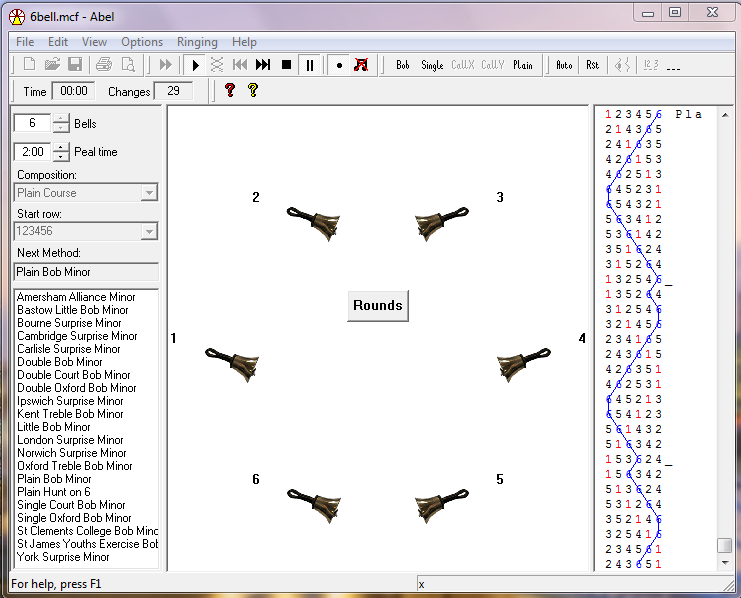Handbell simulation
Learning methods
Towerbell ringers can learn methods and test themselves quite easily by reciting the work of a method or by drawing out the blue line on paper. If they can do this quickly and without error, and their ropesight is good, they can be confident that this will translate into a reliable performance in the tower. However, for handbell ringers it is much harder to confirm whether they know a method well enough to ring it on handbells, because knowing a single line or a grid pattern doesn’t mean that you can ring two bells based upon this knowledge. To demonstrate that you know a method by drawing it on paper, you would have to be able to draw two lines simultaneously. This is impracticable. The alternative, and one that some handbell ringers use, is to practise methods with a simulator, using two keys on the keyboard to ring their two bells while the simulator rings the rest.
Some ringers seem to manage to ring a simulator such as Abel using the keyboard quite successfully, but it is generally acknowledged that this is much harder than practising with real ringers. There are a number of reasons for this:
- There is no distinction between handstroke and backstroke when pressing keys. Abel’s keyup/keydown option helps with this, but it is no substitute for swinging one's arms up and down.
- Using the keyboard you cannot “internalise” a rhythm based upon the movement of your arms and the timing of the swing.
- The handbell equivalent of “ropesight” is difficult as Abel’s screen bells flip instantly between strokes. With real ringers you see the bell you are going to follow start to move and this helps you anticipate the swing of your own bell to ring after it. Abel now has an option for "moving handbells" which move the bells smoothly, more closely simulating the real world situation.
Dummy Handbells
Abel’s documentation suggests using dummy handbells with electronic switches for clappers to overcome the first two points and includes a design to help individuals build their own. Although a few people have successfully built dummy handbells for their own use, mechanical designs are prone to problems such as bounce and unwanted rattle, the design is beyond many ringers' DIY skills and no one has built any for general sale to others.
Handbell Manager
Handbell Manager is free software (under the GNU General Public Licence) that enables USB motion controllers to be used as dummy handbells with Abel or Beltower. Click on play below to see a demonstration video of three leads of Bristol using Abel, Handbell Manager and ActionXL wired motion controllers.
There is no computer keyboard or mouse interaction during the video – the controllers are swung to ring two bells and buttons on the controllers are used to start the others ringing, initiate "Go Bristol" and call the three bobs.
What do you need?
Two ActionXL USB motion controllers, available from:
- changeringing.co.uk at £11.75 each
- actionxl.com/products.html at $19.95 each.
Simulator software available from:
- Abel version 3.7 or later – abelsim.co.uk
- Beltower 10.27 or later – beltower.co.uk
Handbell Manager available from:
A PC with two spare USB ports, Microsoft Windows and .Net Framework.
Reproduced with the kind permission of Graham John
Screenshots

Abel set up for ringing handbells

Handbell Manager
» Smartphones and tablets – Mobel & Methodology